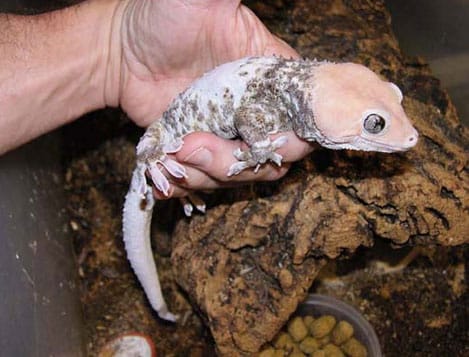The tokay gecko is a well-known but poorly understood, species.
Updated February 8, 2023
The vibrant and unusual-looking tokay gecko (Gekko gecko) is a well-known, but poorly understood, species. Heavy-bodied and nocturnal, these tropical animals have a reputation for being aggressive, hard to handle and apt to bite. However, they can be the ideal captive for a patient geckokeeper. They are fascinating to observe, and with a little invested time, they can be tamed into tractable little beasts.
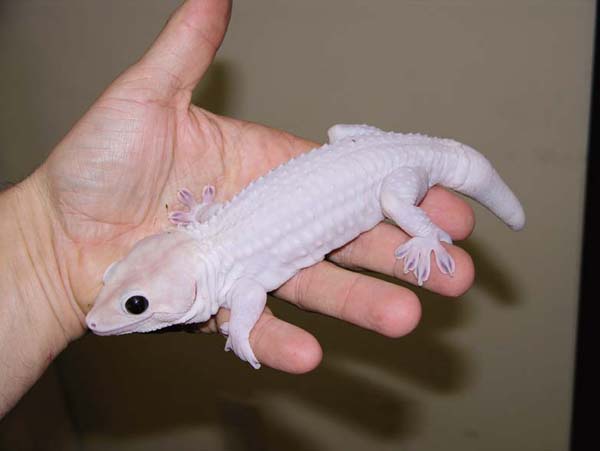
This leucistic morph sits comfortably in the handler’s hand because it is held loosely and does not feel threatened. Photo by Kevin McCurley
Tokay Gecko Enclosure
Inhabiting much of Southeast Asia, including areas populated by people, tokay geckos can grow up to 15 inches long. They are estimated to live about 10 years in captivity. They do best in enclosures mimicking their natural environment, and providing them with adequate space and hiding spots. Tokays can be kept in planted vivaria, but they may unleash their destructive fury in smaller-sized enclosures with delicate decorations. A simple setup works well.
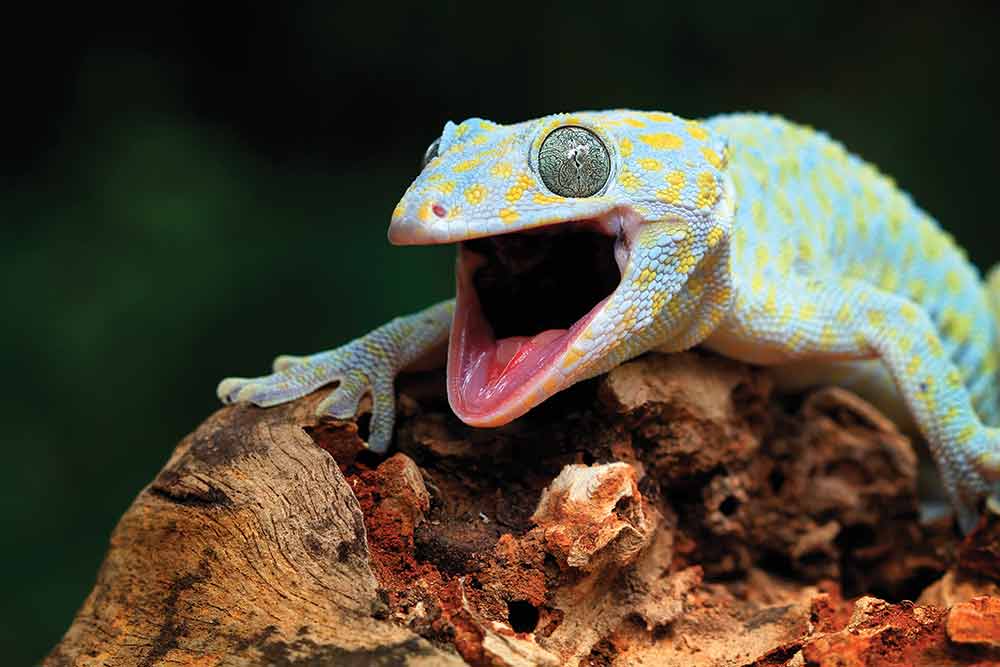
Tokay gecko. Photo by Kurt Afshen/Shutterstock
Tokays are arboreal and appreciate space. The optimal enclosure size for a single or a pair should be 24”L x 24”W x 48”H. Newspaper is effective as a substrate. It’s not the most aesthetically pleasing, but it’s easy to maintain. Cypress mulch or orchid bark may be used to help maintain humidity. Coco peat and sphagnum moss also work, but they may stick to the animal in damp conditions. A protective layer of long-fiber sphagnum moss over such bedding prevents things from becoming too messy. A 3- to 4-inch layer of substrate that can be misted to increase ambient humidity makes for effective bedding. Tokays love a cluttered cage. They appreciate live and artificial plants, sticks, driftwood, caves, and pretty much anything they can climb on or hide in.
Safe hiding places are essential for tokay geckos. They need a secure area where they can sleep during the day and not feel threatened. Fake caves, hide boxes, tunnels, logs, and PVC or bamboo tubes make good hides. I like to provide several within the enclosure to give the animals a chance to choose according to temperature and security. At least provide one near the heat source and another away from the hotspot. Tokays generally seem to like tightfitting hides, so an adult is more likely to appreciate a piece of PVC 11⁄2 to 2 inches in diameter than one 3 to 4 inches in diameter. Baby geckos seem to enjoy hiding in small cracks. Once a gecko gets in its hide area, it may be difficult to get it out. Provide a water dish in a cage corner. Prevent feeder insects from drowning by placing a small object, such as a sponge or stone, in it that allows them to climb out of the water. Tokay geckos may ignore the bowl, so additional water spraying is essential.
Tokay Gecko Humidity Requirements
Tokays require high humidity and good ventilation. They will not survive in a constantly wet or damp environment. High humidity with inadequate ventilation can cause fungal or bacterial issues. They must be able to dry out, but if kept too dry, they suffer from stuck sheds, which can be difficult to remove, especially around the toe pads. Keep humidity between 60 and 80 percent, and use a screen cover that allows the cage to breathe.
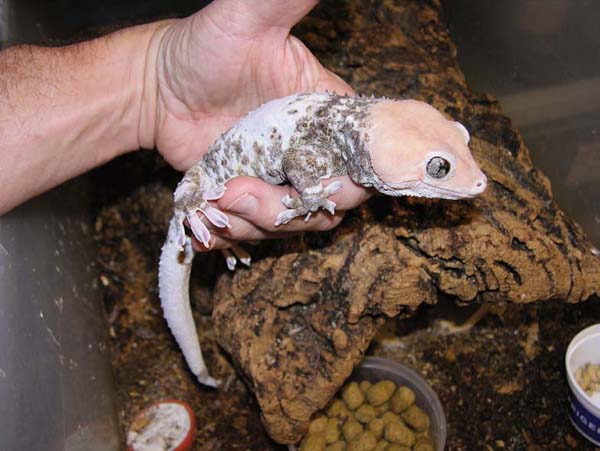
It took effort to tame this peach-headed leucistic morph named Lucifer. The author started gaining the lizard’s trust by coaxing it out of its hide onto his hand. Photo by Kevin McCurley
Spraying the cage just before the lights go off raises cage humidity by imitating a short rainstorm. It also is a good way to ensure that your lizard gets enough water. Droplets collect on fixtures and give the gecko an opportunity to drink. Many of my tokays do not like to be sprayed directly and protest if they get wet. Some seem less offended by a fine water spray and may even enjoy it. The trick is to spray down the enclosure enough so water droplets remain for a few hours, yet the enclosure dries out overnight. If it is too wet and the animals remain damp or cold, they will not thrive. If there is not enough water spray, then they may fail to drink and become dehydrated in low humidity situations. Utilizing a dripper system is another way to provide water. These systems work well with many lizard species.
Optimal ambient air temperatures for tokays are between 80 and 85 degrees Fahrenheit, but the geckos tolerate nighttime drops down into the mid-70s. A basking spot of 90 to 105 degrees is ideal. Monitor it with a thermometer. Red light bulbs or ceramic heat emitters create effective basking spots for this nocturnal species. Do not use spotlights that focus UVA heat; they may burn the lizard. Tokay geckos spend much of their time hiding or sleeping during daylight hours. Once the lights go out and the animal is comfortable, it investigates its environment. My tokays become active a few minutes after the lights go out. Keepers who visit their tokays at night may notice that they can be heard rushing back to their retreat until the “danger” passes. Generally, 12 to 14 hours of daylight and a subsequent night cycle is effective for this species. A UVB-emitting fluorescent can provide this daylight, but don’t leave bulbs on continuously. This may stress lizards and disturb their secretive nature. I have found that my tokays like to bask near UVB coil bulbs. In the wild I assume this species exposes parts of its body to natural sunlight to help regulate vitamin D3, which is essential for many lizard species’ well-being and health.
Tokay Gecko Food
Opportunistic feeders, tokay geckos consume just about anything they can overpower. In the wild much of their diet consists of insects and other lizards. In captivity they do well on a mix of crickets, mealworms, roaches, waxworms, hornworms, silkworms and small mice. Some captives can be trained to eat defrosted fuzzies from tongs. This is a great way to bulk up your pet. Gut load all feeder insects to ensure the most complete nutrition because the gecko benefits from the insect’s last meal. Use a mix of leafy greens, vegetables, fruit and commercial gut-loading products for your feeder insects.
Dust feeders at least once a week with powdered calcium to ensure a calcium and mineral source for tokays. If your geckos are not exposed to UVB lighting, use calcium with vitamin D3, which is commonly used for nocturnal lizard species. This ensures proper bone growth and a healthy nervous system for the lizard. Placing a shallow dish filled with a supplement in a corner of the cage is a good idea. Many lizards will visit the dish and take what they need. I prefer ultrafine calcium powder that is nearly tasteless and sticks well to crickets.
Honor Social Codes
Immature captive-bred males generally tolerate each other but not when they get older. As they mature, the strongest male chases away all rivals in his territory. The subordinate male often becomes injured or suddenly fails to thrive. Don’t house mature adult males together because injury or death is often the result. Note that established adult females that have laid eggs in a cage often attack, injure or kill new females added later, too.
The classic tokay vocalization is a male announcing his presence to rival males and calling to lure females. In fact, the sound mimics their name when they call out “toke-kay. If you are setting up animals, a male and female pair displaying the least amount of aggression toward each other is best. Some animals just do not like each other. It is important to recognize conflict among cagemates and to remove incompatible animals when necessary. Trios of one male and two females can work, too, but set up new trios at the same time. I have made the mistake of adding an additional female to an established male-female pair. By the next morning the new female was nearly dead from her injuries as the pair tried to drive her out of their territory. In the wild male tokays are very territorial, but they allow females into their territory to mate, lay a clutch of eggs, leave, and return to mate and lay more eggs. Males generally guard the eggs in this situation. In captivity both males and females typically guard the eggs. I believe that pairs often bond, and this is a great sign that the pair is compatible. In these cases, do not add more animals to the cage.
Can You Tame A Tokay Gecko?
Tokays can be difficult to handle without one freaking out, escaping, running up the wall or biting the handler. They are amazingly powerful and fast, and their sophisticated toe pads allow them to adhere to almost anything. Your objective is to have short, positive sessions with the lizard where it sits on your hand without you restraining or hurting it.
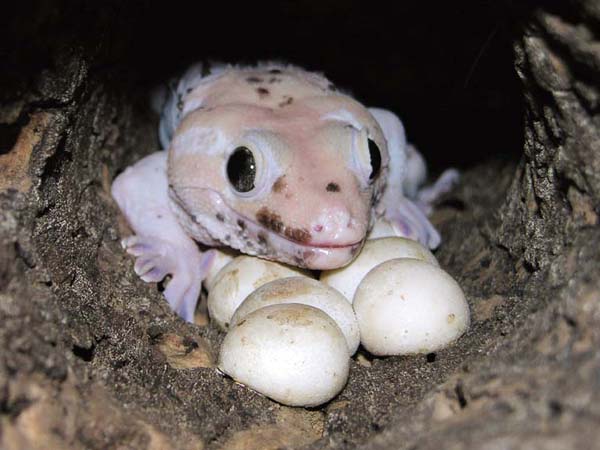
A male leucistic tokay gecko protects these eggs. Both sexes protect eggs in captivity. Photo by Kevin McCurley
The golden rule of tokay handling is to build trust with the lizard. If you are trying to tame this beast, you cannot grab it behind the head and manhandle it. I generally try to coax the animal out of its hide and onto my hand. Always keep your hand flat, and keep it under the lizard so you don’t get bitten. Generally tokays explode from their hides and run in all directions. At this point the trick is to get the lizard back onto your hand and hold it over your head. Your eyes are intimidating, and if you put the lizard above you, it may decide that your hand is a good place to collect its thoughts. Once your gecko is sitting on your hand, lightly stroke the underside of its tail with your other hand. Do this for a few minutes, and then calmly put the lizard back into its cage. However, be aware it may freak out and bolt, launching into the air and landing on the floor. Position yourself somewhere it won’t get hurt. It also helps to handle your gecko in an area where it cannot escape or hide behind something. At first, returning tokays to their enclosures without incident may seem impossible, but it takes patience and nerves to gain the trust of this species. As you do, the lizard starts to realize that you are not hurting it.
As the gecko calms, you can eventually bring it down to body level while still stroking the underside of its tail and very gently coax it to walk from the back of one hand to the other. A walking gecko is a very good sign that the animal is calming down and thinking. Once you can get your tokay to walk on your hands or arm, observe whether it licks as it walks, tasting its environment. If you see this, you are very close to having a friendly tokay. Tokay geckos are terrified and mistrusting, but with good cause. This species is collected from the wild in great numbers to satisfy some cultures’ medicinal beliefs. They are mounted on sticks, dried and sold as a cure-all. The entire process is extremely cruel without a lick of science to validate the gecko’s medicinal values. Some animals are also collected for the pet trade and undergo a terrifying process before they ever end up in a vivarium. In my opinion tokays are intelligent, reactive and inquisitive. To tame one, you have to convince the lizard that you mean it no harm. Otherwise it will try to defend itself or flee from you.
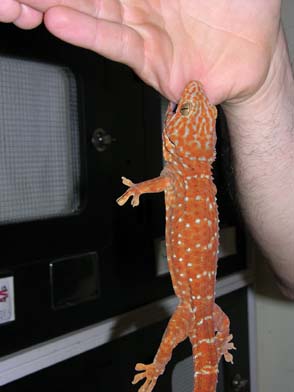
Tokay geckos do bite and have powerful jaws. Photo by Kevin McCurley
Once tame, this species is reluctant to bite, and it can be handled much like a leopard gecko. A friendly captive tokay gecko is both an accomplishment and proof of your geckokeeping skills.
Sexing Tokays
Tokay geckos are not the easiest lizards to sex. They should have adequate conditioning first. The lizards tend to writhe and wiggle when restrained, so accurate sexing is difficult if one is unfamiliar with the process.
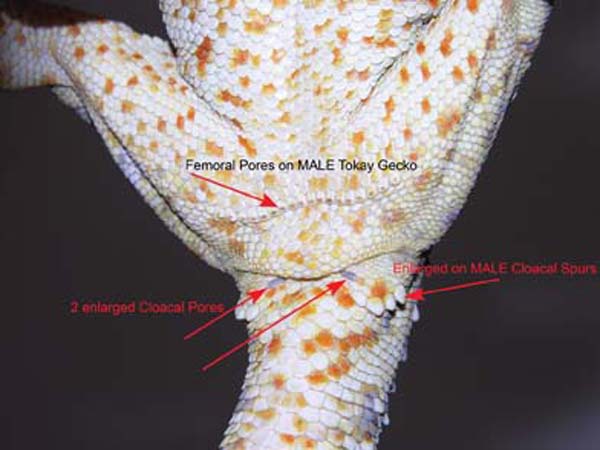
Male Tokay gecko. Photo by Kevin McCurley
Sex mature animals by looking for the presence of femoral pores. Turn the animal over while carefully securing the lizard behind its head. Observing tokays kept in glass-walled cages can give a keeper a good look at the ventral surface of the lizard while leaving the animal undisturbed. Although identifying a male’s enlarged pores is the most definitive sexing method, males also tend to grow larger, and they have proportionately wider heads than females. In addition to femoral pore sexing, check the pair of anal pores beneath the lizard’s vent. Males have larger pores, but a female’s are smaller and less obvious.
Admire Their Qualities
Tokay geckos are not the simple lizards some herpkeepers may think they are. Seemingly aware of their surroundings and circumstances, they have proven to be high-strung due to above-average intelligence. To me, tokay geckos are similar to reticulated pythons: Known to be aggressive, they are alert, high-strung and challenging to keep.
Tokay geckos are infamous for biting. Generally there are two types of bites. One is a warning bite where the lizard stands its ground while your hand invades its territory, the enclosure. Although generally ferocious in appearance, this bite causes only superficial damage. Little or no bleeding is the result. Remember, the gecko is trying to scare you away and does so by showing you it means business. The behavior seems more common with males than females. The second type of bite is the defensive bite, which generally occurs when you grab the gecko with your hands. At this point you have “attacked” the lizard, and it will bite to defend itself. It may clamp down on anything it can grab — and not let go. This bite is often both painful and long-lived. Tokays have incredibly strong jaws and sharp little teeth. The best course of action with such a bite is to release your grasp on the animal, and place it on a surface where it feels it has a chance to dash away. Hold still and wait; once it feels it can get away, it is more likely to let go.
Tokays may be a much greater challenge than leopard or crested geckos, but these colorful gems are worth the effort. These days they come in a variety of morphs. For the dedicated geckokeeper, they are an intelligent, inquisitive captive. Kevin McCurley is the founder and owner of New England Reptile Distributors Inc. His breeding efforts initially focused on large colubrids and eventually reticulated pythons. He is especially known for his beautiful morphs. To view more of his unique quality reptiles, visit newenglandreptile.com.

